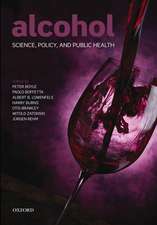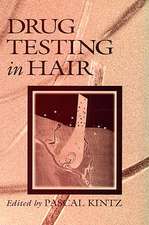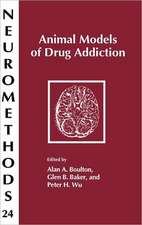Buprenorphine Therapy of Opiate Addiction: Forensic Science and Medicine
Editat de Pascal Kintz, Pierre Marqueten Limba Engleză Hardback – 5 feb 2002
| Toate formatele și edițiile | Preț | Express |
|---|---|---|
| Paperback (1) | 771.50 lei 6-8 săpt. | |
| Humana Press Inc. – 12 dec 2012 | 771.50 lei 6-8 săpt. | |
| Hardback (1) | 1093.72 lei 6-8 săpt. | |
| Humana Press Inc. – 5 feb 2002 | 1093.72 lei 6-8 săpt. |
Din seria Forensic Science and Medicine
- 5%
 Preț: 773.68 lei
Preț: 773.68 lei - 5%
 Preț: 1348.86 lei
Preț: 1348.86 lei - 5%
 Preț: 1418.48 lei
Preț: 1418.48 lei - 5%
 Preț: 1637.37 lei
Preț: 1637.37 lei - 5%
 Preț: 1285.88 lei
Preț: 1285.88 lei - 15%
 Preț: 696.50 lei
Preț: 696.50 lei - 5%
 Preț: 1418.83 lei
Preț: 1418.83 lei - 5%
 Preț: 1096.62 lei
Preț: 1096.62 lei - 5%
 Preț: 1290.11 lei
Preț: 1290.11 lei - 5%
 Preț: 772.02 lei
Preț: 772.02 lei - 5%
 Preț: 1431.66 lei
Preț: 1431.66 lei - 5%
 Preț: 1953.54 lei
Preț: 1953.54 lei - 5%
 Preț: 1421.06 lei
Preț: 1421.06 lei - 5%
 Preț: 2148.86 lei
Preț: 2148.86 lei - 5%
 Preț: 1430.00 lei
Preț: 1430.00 lei - 5%
 Preț: 1099.20 lei
Preț: 1099.20 lei
Preț: 1093.72 lei
Preț vechi: 1151.28 lei
-5% Nou
Puncte Express: 1641
Preț estimativ în valută:
209.31€ • 227.28$ • 175.82£
209.31€ • 227.28$ • 175.82£
Carte tipărită la comandă
Livrare economică 22 aprilie-06 mai
Preluare comenzi: 021 569.72.76
Specificații
ISBN-13: 9781588290311
ISBN-10: 158829031X
Pagini: 168
Ilustrații: 168 p. 22 illus.
Dimensiuni: 152 x 229 x 15 mm
Greutate: 0.4 kg
Ediția:2002
Editura: Humana Press Inc.
Colecția Humana
Seria Forensic Science and Medicine
Locul publicării:Totowa, NJ, United States
ISBN-10: 158829031X
Pagini: 168
Ilustrații: 168 p. 22 illus.
Dimensiuni: 152 x 229 x 15 mm
Greutate: 0.4 kg
Ediția:2002
Editura: Humana Press Inc.
Colecția Humana
Seria Forensic Science and Medicine
Locul publicării:Totowa, NJ, United States
Public țintă
Professional/practitionerCuprins
1 Pharmacology of High-Dose Buprenorphine.- 1. Introduction.- 2. Pharmacokinetic Properties.- 3. Pharmacodynamic Properties.- 4. Administration Schedules.- 5. Clinical Effects of Buprenorphine.- 6. Conclusion.- References.- 2 Controlled Drug Administration Studies of High-Dose Buprenorphine in Humans.- 1. Introduction.- 2. Bioavailability.- 3. Dose-Effect Profiles.- 4. Abuse Liability.- 5. Toxicity.- 6. Safety and Abuse Liability of High-Dose Intravenous Buprenorphine.- 7. Conclusion.- References.- 3 High-Dose Buprenorphine for Treatment of Opioid Dependence.- 1. Introduction.- 2. Buprenorphine Solution vs Tablets.- 3. Efficacy of Buprenorphine vs Placebo: Clinical Trials.- 4. Efficacy of Buprenorphine vs Other Medications: Clinical Trials.- 5. Safety and Side Effects of Buprenorphine.- 6. Summary and Conclusions.- Acknowledgment.- References.- 4 Foreseeable Advantages and Limits of Buprenorphine-Naloxone Association.- 1. Introduction.- 2. Advantages of Buprenorphine-Naloxone Association.- 2.1.1. Epidemic of Pentazocine and Tripelennamine Abuse in the United States.- 2.1.2. Epidemic of Analgesic Buprenorphine Abuse in New Zealand.- 3. Limits of Buprenorphine-Naloxone Association.- 4. Conclusion.- References.- 5 Buprenorphine Maintenance Treatment in Primary Care: An Overview of the French Experience and Insight Into the Prison Setting.- 1. Introduction.- 2. Implementation of BMT Through French Primary Care System.- 3. Observable Effects of French Policy.- 4. Prison.- 5. Conclusion.- Acknowledgments.- References.- 6 Buprenorphine as a Viable Pharmacotherapy in Australia.- 1. Introduction.- 2. Buprenorphine.- 3. National Evaluation of Pharmacotherapies for Opioid Dependence.- 4. Conclusion.- Acknowledgments.- References.- 7 Separative Techniques for Determination of Buprenorphine.- 1. Introduction.- 2. Determination of Buprenorphine in Blood.- 3. Determination of Buprenorphine in Urine.- 4. Determination of Buprenorphine in Biological Tissues.- 5. Determination of Buprenorphine in Hair.- 6. Conclusion.- References.- 8 Buprenorphine-Related Deaths.- 1. Introduction.- 2. Forensic Aspects.- 3. Buprenorphine Fatalities.- 4. Conclusion.- References.- 9 Pharmacology of Opiates During Pregnancy and in Neonates.- 1. Introduction.- 2. Perinatal Pharmacokinetics of Opiates.- 3. Perinatal Pharmacodynamics of Opiates.- 4. Maintenance Treatments During Pregnancy.- References.- 10 Case Study of Neonates Born to Mothers Undergoing Buprenorphine Maintenance Treatment.- 1. Introduction.- 2. Clinical Findings.- 3. Toxicological Investigations.- 4. Discussion.- 5. Conclusion.- Acknowledgments.- References.- 11 Buprenorphine and Pregnancy: A Comparative, Multicenter Clinical Study of High-Dose Buprenorphine vs Methadone Maintenance.- 1. Introduction.- 2. Materials and Methods.- 3. Results.- 4. Discussion.- 5. Conclusion.- Acknowledgments.- References.
Recenzii
Foreword by Albert D. Fraser
"This is a very useful and timely book in addiction medicine. . .This book details the use of buprenorphine with its risks and benefits. It draws extensively from available studies and literature, which are listed very clearly in tables. Some of the appendixes are especially useful for quick references. This is a very useful and easy to read book. It details the use of buprenorphine therapy as an alternate to methadone treatment. It also details the analytical advances in testing for buprenorphines. The book describes buprenorphine's pharmacology and current prescription practices in France. It also discusses the use of buprenorphine in various scenarios including in pregnant addicts, and provides a source of knowledge for everyone working in addiction medicine."-Doody's Health Sciences Book Review Journal
"This is a further volume in the growing Forensic medicine and Science Series edited by Steve Karch. This impressive series embraces a range of forensic topics. The style is now familiar, good topic editors with a broad spectrum of specialist authors contributing within their own area of expertise...good topic editors with a broad spectrum of specialist authors contributing within their own area of expertise....worthwhile reading for anyone in contact with patients who are opiate addicted." - Nil Aggrawal's Internet Journal of Forensic Medicine and Toxicology
"This is a very useful and timely book in addiction medicine. . .This book details the use of buprenorphine with its risks and benefits. It draws extensively from available studies and literature, which are listed very clearly in tables. Some of the appendixes are especially useful for quick references. This is a very useful and easy to read book. It details the use of buprenorphine therapy as an alternate to methadone treatment. It also details the analytical advances in testing for buprenorphines. The book describes buprenorphine's pharmacology and current prescription practices in France. It also discusses the use of buprenorphine in various scenarios including in pregnant addicts, and provides a source of knowledge for everyone working in addiction medicine."-Doody's Health Sciences Book Review Journal
"This is a further volume in the growing Forensic medicine and Science Series edited by Steve Karch. This impressive series embraces a range of forensic topics. The style is now familiar, good topic editors with a broad spectrum of specialist authors contributing within their own area of expertise...good topic editors with a broad spectrum of specialist authors contributing within their own area of expertise....worthwhile reading for anyone in contact with patients who are opiate addicted." - Nil Aggrawal's Internet Journal of Forensic Medicine and Toxicology
Textul de pe ultima copertă
Buprenorphine, a semisynthetic opioid derivative, has been prescribed widely and uniquely in France as an alternative to methadone for the treatment of heroin-addicted patients during the last five years. In Buprenorphine Therapy of Opiate Addiction, participating physicians and toxicologists summarize and evaluate their experiences with this still uncommon drug, covering all aspects of its use, including the pharmacology, conditions of delivery, risks from use with other psychoactive drugs, toxicology and related deaths, as well as its testing in blood, urine, tissue, and hair. Special attention is given to comparing the long-term care of opiate-dependent patients using high-dose buprenorphine vs methadone, and to explaining the differences in treatment, administration, and delivery. The authors also describe how buprenorphine is currently prescribed and monitored in France and Australia, and review all the latest advances in analytical techniques for the determination of buprenorphine and its metabolites in biological fluids and tissues. Special coverage is given to the use of buprenorphine in the pregnant addict, the risks of buprenorphine overdosing and poisoning, and the effects of combining buprenorphine and naloxone.
Comprehensive and groundbreaking, Buprenorphine Therapy of Opiate Addiction covers all the key topics that both treatment personnel and forensic laboratory scientists in the addiction field need to appreciate the success of buprenorphine therapy, and to prepare for its implementation in their own countries.
Comprehensive and groundbreaking, Buprenorphine Therapy of Opiate Addiction covers all the key topics that both treatment personnel and forensic laboratory scientists in the addiction field need to appreciate the success of buprenorphine therapy, and to prepare for its implementation in their own countries.
Caracteristici
Includes supplementary material: sn.pub/extras




















